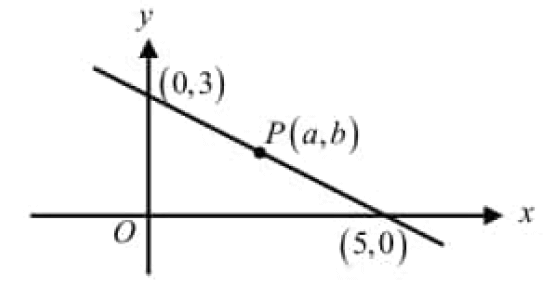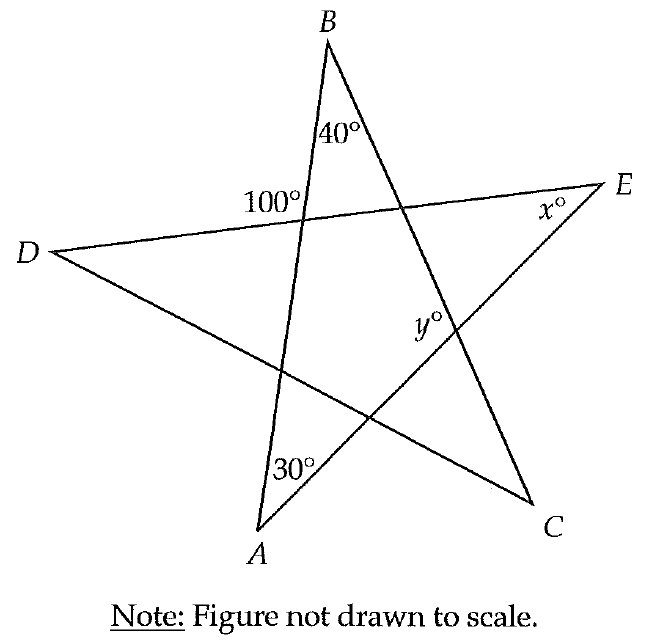FINDING ANGLES INVOLVING ISOCELES TRIANGLE
Problem 1 :
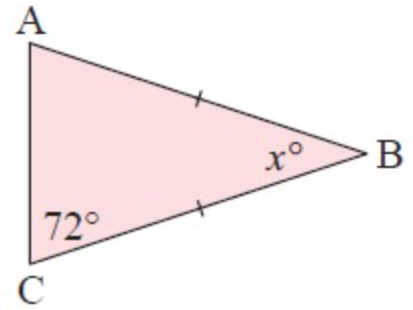
Solution :
Given, AB = BC and <ABC = xº
<BAC = <BCA = 72º
In triangle ABC.
<BAC + <BCA + <ABC = 180º
72º + 72º + xº = 180º
144º+ xº = 180º
xº = 180º - 144º
xº = 36º
Problem 2 :
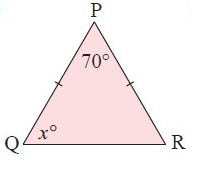
Solution :
Given, PQ = QR and <PQR = xº
<QPR = 70º and <PRQ = xº
In triangle PQR.
<QPR + <PRQ + <PQR = 180º
70º + xº + xº = 180º
70º + 2xº = 180º
2xº = 180º - 70º
2xº = 110º
xº = 110/2
xº = 55º
Problem 3 :
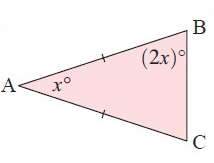
Solution :
Given, AB = AC and <BAC = xº
<ABC = <BCA = (2x)º
In triangle ABC.
<ABC + <BCA + <BAC = 180º
(2x)º + (2x)º + xº = 180º
4xº + xº = 180º
5xº = 180º
xº = 180º/5
xº = 36º
Problem 4 :
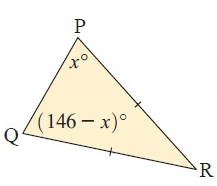
Solution :
Given, PR = QR and <QPR = xº
Since PR and QR are equal, it is isosceles triangle.
<PQR = <QRP = (146-x)º
x = 146-x
x+x = 146
2x = 146
x = 73
So, the value of x is 73.
Problem 5 :
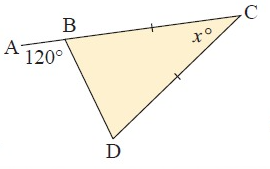
Solution :
Given, BC = BD and <BCD = xº
<CBD = <BDC = 60º
In triangle ABCD,
<DBC + <ADB + <BCD = 180º
60º + 60º + xº = 180º
xº = 180º - 120
xº = 60º
Problem 6 :
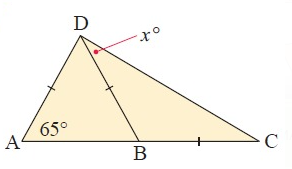
Solution :
Given, AD = BD = BC and <BDC = xº
<DBA = <BAD = 65º
<ABD + <DBC = 180
65 + <DBC = 180
<DBC = 180-65
<DBC =115
<BDC = <BCD = x
In triangle BDC.
<BDC + <DBC + <DCB = 180
x+115+x = 180
2x+115 = 180
2x = 65
x = 65/2
Problem 7 :
In the figure given below, PQ = PS. The value of x is
a) 35 b) 45 c) 55 d) 70
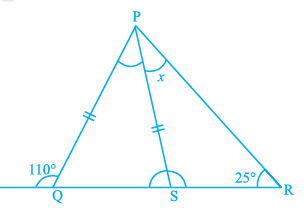
Solution :
<PQS = 180 - 110 ==> 70
Since PQ and PS are equal, <PQS = <PSQ
<PSQ = 70
In triangle PQS,
<PQS + <PSQ + <SPQ = 180
70 + 70 + <SPQ = 180
<SPQ = 180 - 140
<SPQ = 40
In triangle PQR,
<PQR + <QPR + <PRQ = 180
70 + <QPS + <SPQ + 25 = 180
95 + 40 + <SPQ = 180
135 + <SPQ = 180
<SPQ = 180 - 135
<SPQ = 45
So, option b is correct.
Problem 8 :
Find the measures of the angles of an isosceles triangle if the measure of the vertex angle is 40 degrees less than the sum of the measures of the base angles.
Solution :
Let x be the base angles.
Vertex angle = (x + x) - 40
= 2x - 40
Sum of interior angles of a triangle = 180
x + x + 2x - 40 = 180
4x - 40 = 180
4x = 180 + 40
4x = 220
x = 220/4
x = 55
Applying x = 45 in 2x - 40
= 2(55) - 40
= 110 - 40
= 70
So, the required angles are 55, 55 and 70.
Problem 9 :
In an isosceles triangle, one angle is 70°. The other two angles are of
(i) 55° and 55° (ii) 70° and 40° (iii) any measure
In the given option(s) which of the above statement(s) are true?
(a) (i) only (b) (ii) only (c) (iii) only (d) (i) and (ii)
Solution :
In any isosceles triangle, two angle measures will be equal. We are not sure about the given angle is equal angles or not.
Case 1 :
Let the given angle be equal angle measures of isosceles triangle.
Let the other angle be x
70 + 70 + x = 180
x = 180 - 140
x = 40
In this case, the required angles are 40, 70 and 70
Case 2 :
Let the given angle measure be vertex angle, then the two base angles are being considered as x.
x + x + 70 = 180
2x + 70 = 180
2x = 180 - 70
2x = 110
x = 110/2
x = 55
In this case, the required angles are 55, 55 and 70.
So, option d is correct.
Problem 10 :
In a triangle, one angle is of 90°. Then
(i) The other two angles are of 45° each
(ii) In remaining two angles, one angle is 90° and other is 45°
(iii) Remaining two angles are complementary In the given option(s) which is true?
(a) (i) only (b) (ii) only (c) (iii) only (d) (i) and (ii)
Solution :
In a triangle, sum of interior angles will be equal to 180.
Since one angle measure is 90, then the sum of the other two angles measures should be 90. Which means they should be complementary angles. So, option c is correct.
Kindly mail your feedback to v4formath@gmail.com
We always appreciate your feedback.
©All rights reserved. onlinemath4all.com
Recent Articles
-
Digital SAT Math Problems and Solutions (Part - 134)
Apr 02, 25 12:40 AM
Digital SAT Math Problems and Solutions (Part - 134) -
SAT Math Resources (Videos, Concepts, Worksheets and More)
Apr 02, 25 12:35 AM
SAT Math Resources (Videos, Concepts, Worksheets and More) -
Digital SAT Math Problems and Solutions (Part 135)
Apr 02, 25 12:32 AM
Digital SAT Math Problems and Solutions (Part 135)
